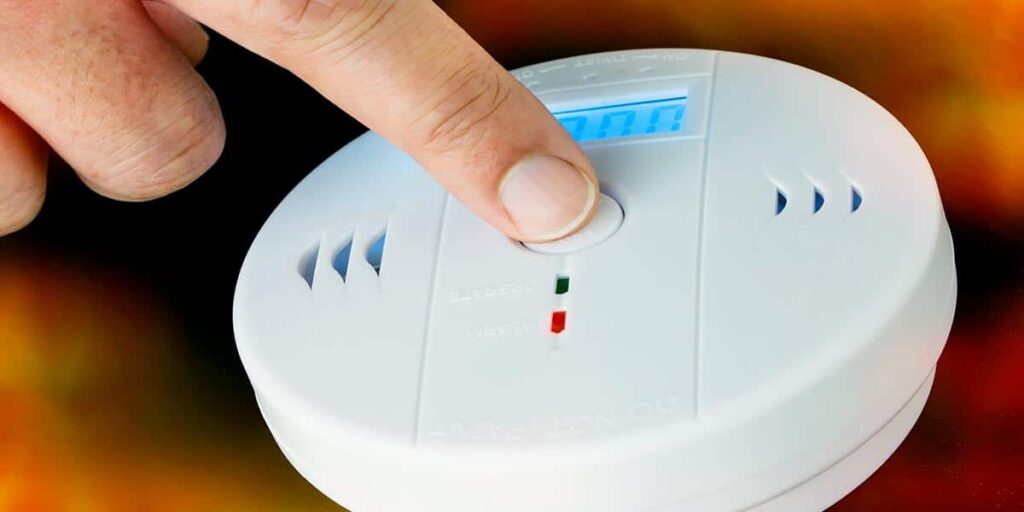Why Should I Install a Carbon Monoxide Detector?
Carbon monoxide poisoning can occur at any time in your home. A carbon monoxide detector can keep your family safe—here’s why you should install them.
If you plan to remodel your home or are in the midst of the process, chances are you’ve had to remove your smoke and carbon monoxide detectors.
Failure to reinstall a carbon monoxide detector can have fatal consequences. Even exposure to small doses of carbon monoxide can be lethal.
Considering 39 percent of American homes don’t have a carbon monoxide detector installed, it’s a reasonable assumption that you might forget to reinstall your devices when the time comes.
The best way to prevent carbon monoxide poisoning is to use carbon monoxide detectors in your home. Moreover, you need to be sure your carbon monoxide detectors are installed properly.
What Is Carbon Monoxide?
Carbon monoxide is a colorless, odorless gas found in combustion fumes. A fireplace, gas stove, car engine, charcoal grill, and portable generator all produce some level of carbon monoxide gas.
Most people inhale trace amounts of carbon monoxide every day. Breathing in more of the gas is very dangerous and can lead to carbon monoxide poisoning.
How Does Carbon Monoxide Poisoning Occur?
In a poorly ventilated or enclosed space, combustion fumes can build up and become trapped. This causes carbon monoxide to rise to dangerous levels.
Inhaling carbon monoxide fumes causes them to build up in the bloodstream and leads to severe tissue damage. Carbon monoxide binds with the body’s red blood cells and starves it of oxygen once it enters the lungs.
Everyone is at risk of carbon monoxide poisoning at some time or another. The risk of carbon monoxide poisoning increases when a person is in close proximity to common household appliances.
These appliances include:
- fuel-burning space heaters
- gas stoves or stovetops
- water heaters
- fireplaces
- furnaces
- recreational vehicles with gas heaters
- idling vehicles inside garages and enclosed spaces
These appliances only release minute amounts of carbon monoxide gas. They can be dangerous when used in areas with poor ventilation.
It is very important to place carbon monoxide detectors near these types of appliances. Ensure there is plenty of ventilation in rooms where these appliances often reside. Such rooms include basements, attics, kitchens, and garages.
Carbon monoxide poisoning is serious and life-threatening. It is important to get emergency medical assistance for anyone showing signs of carbon monoxide poisoning.
Symptoms of Carbon Monoxide Poisoning
When you breathe in carbon monoxide, your body begins to replace the oxygen contained in your blood with gas. When the build-up of carbon monoxide in the body causes unconsciousness it can lead to death.
The common symptoms of carbon monoxide poisoning include:
- weakness
- nausea
- vomiting
- dull headache
- confusion
- dizziness
- difficulty breathing
If you experience any of these symptoms in relation to inhaling carbon monoxide, it is important to move outdoors and call 911 right away.
Long-Term Risks of Carbon Monoxide Poisoning
Carbon monoxide poisoning can have serious lifelong consequences. This is true even when a person survives the initial poisoning.
Some of the complications of carbon monoxide poisoning include heart damage, brain damage, organ damage, and death.
Benefits of Using a Carbon Monoxide Detector
Since it is odorless and invisible, carbon monoxide gas is almost impossible to detect without a sensor.
Carbon monoxide poisoning kills over 400 people each year on average. In these cases, the deaths were due to carbon monoxide poisoning unrelated to a fire.
Installing carbon monoxide detectors around your home can save your life and protect the life of anyone who spends time in your home.
The best chance of avoiding poisoning by carbon monoxide is to have a professionally installed carbon monoxide detector in the main rooms and hallways of your home.
How Do Carbon Monoxide Detectors Work?
Carbon monoxide detectors work similarly to smoke detectors. When the detector senses the presence of carbon monoxide, it sounds a siren to alert you.
The siren will sound when it detects a significant amount of carbon monoxide in your home or the room where it is installed. This will usually happen before you start experiencing symptoms of carbon monoxide poisoning.
When the carbon monoxide detector senses high levels of carbon monoxide gas, such as 150 ppm or more, it will trigger the alarm within minutes.
When the levels are lower, such as 50 ppm, it can take hours for the alarm to go off.
Most people feel the effects of carbon monoxide exposure when levels reach 70 ppm. It is important to act quickly when a carbon monoxide alarm sounds. Low doses of the toxic gas over long periods of time are also deadly.
Types of Carbon Monoxide Detectors
There are a few different types of carbon monoxide sensors you can choose from. These include biometric sensors, metal oxide semiconductors, and electrochemical sensors.
Biometric Sensors
Biometric sensors contain a type of gel. This gel changes color when it absorbs carbon monoxide. The change in color is what triggers the biometric alarm.
Metal Oxide Semiconductors
A metal-oxide semiconductor uses a silica chip to detect carbon monoxide. When the circuitry of the silica chip detects the gas, it lowers the chip’s electrical resistance. This change in electricity triggers the alarm.
Electrochemical Sensors
Electrochemical sensors use electrodes immersed in a chemical solution. When these electrodes come into contact with carbon monoxide, they sense a change in electrical currents and trigger the alarm.
Keep in mind that each of these different types of sensors must be taken to an area free of carbon monoxide gas in order to silence their sirens.
Where to Place Your Carbon Monoxide Detector
Some local laws require a carbon monoxide detector in every bedroom. In most circumstances, however, there are three critical areas of the home in which you should install carbon monoxide detectors.
There should be at least one carbon monoxide detector on every level of the home. This includes the basement and the attic.
Place one carbon monoxide detector near every bedroom and sleeping space. Most states require that you install a carbon monoxide detector within a certain distance of bedrooms.
In a shared hallway, one detector can serve multiple bedrooms as long as their doorways are close enough to one another. It is also important to install carbon monoxide detectors near doors that lead to attached garages.
Consult your local laws and manufacturer instructions for further guidance beyond these three critical locations.
When to Replace Your Carbon Monoxide Detector
All types of carbon monoxide detectors require regular maintenance. Neglecting to maintain your carbon monoxide detector can render it useless.
Test your carbon monoxide detectors once a month by pressing the button and waiting to hear the siren.
The instructions on the device’s manual will tell you how often to replace the batteries. As a rule of thumb, consider replacing them every few months just to be sure.
If your carbon monoxide detector has a wired sensor and a battery backup, you’ll want to make sure both the sensor and the battery are in working order.
Replace your carbon monoxide detectors every few years, or in accordance with the manufacturer’s guidelines.
Other Ways to Prevent Carbon Monoxide Poisoning
In addition to placing carbon monoxide detectors around your home, there are several other things you can do to reduce the likelihood of carbon monoxide poisoning.
Always make sure your carbon monoxide detectors have working batteries. Change the batteries on a regular basis.
Make sure rooms and areas containing appliances that burn gas, wood, propane, or other fuels have excellent ventilation. Windows, doors, and other openings are good ways to ensure proper ventilation in indoor spaces.
Avoid falling asleep or sitting for long periods of time in idling cars parked in enclosed spaces like garages. Never leave the engine of your vehicle running in a closed garage.
Avoid sleeping near gas and kerosene space heaters.
Educate yourself on the symptoms of carbon monoxide poisoning and do not ignore the signs. A headache or a bit of dizziness might seem like a small thing, but if there is a carbon monoxide leak it can quickly turn deadly.
Installing Your Carbon Monoxide Detector
In most cases, municipal codes require that carbon monoxide detectors be hardwired by an electrician to assure the highest level of protection against carbon monoxide.
If you are interested in having a professional install a carbon monoxide detector in your home, you can’t do better than ServiceWise Electric.
They install hardwired smoke/CO2 combination alarms with electrochemical carbon monoxide sensing and battery back-ups for maximum security.
ServiceWise Electric is a family-owned and operated electrical company serving Cherokee County area, as well as Marietta, Acworth Georgia. Contact us today and book an estimate appointment so you can sleep better knowing your family is safe.


